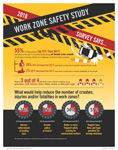AGC Uses Mobile Technology to Make Highway Work Zones Safer
![]() Print this Article | Send to Colleague
Print this Article | Send to Colleague
Fifty-four percent of highway contractors reported that motor vehicles had crashed into their construction work zones during the past year, according to the results of a new highway work zone study conducted by AGC of America. In response, association officials have launched a new mobile advertising campaign urging drivers who routinely pass through certain work zones to slow down and be alert.

Click image to enlarge
"There are simply too many cars crashing into too many work zones, putting too many lives at risk," says Ken Kubacki, chair of AGC’s Highway and Transportation Division, and Western region projects executive of Granite Construction Company in Bakersfield, California. "That is why we are using targeted technology to urge motorists to slow down and drive with care in highway work zones."
Kubacki says that 48 percent of contractors who reported work zone crashes on their projects said that motor vehicle operators or passengers were injured, and 24 percent of those crashes involved a driver or passenger fatality. Highway work zone crashes also pose a significant risk for construction workers, Kubacki notes. He said 25 percent of work zone crashes injure construction workers and 3 percent of those crashes kill them.
Work zone crashes also have a pronounced impact on construction schedules and costs, Kubacki says. He notes that 53 percent of contractors responded that their highway projects have been delayed during the past 12 months because of work zone crashes. He added that 74 percent of responding contractors report they feel highway work zone crashes pose a greater risk now compared to a decade ago.
As a result of the work zone study, AGC has launched a new targeted mobile advertising campaign designed to reach regular highway work zone drivers and urge them to be careful in roadside construction sites before the start of the traditional summer driving season. As part of the campaign, drivers who regularly pass through highway work zones in Pittsburgh, Pennsylvania; St. Louis, Missouri; Birmingham, Alabama and Evansville, Indiana were sent mobile advertising with special work zone safety messages.
Kubacki notes that the ads show up only when the driver opens his or her mobile phone and either visits a web browser like Chrome or Safari, or uses an app with advertisements. The campaign is crafted that way to avoid distracting drivers while they are on the road, instead reaching them when they can safely use their phones. During a span of three weeks earlier this year, over one and a half million motorists have seen the ad, Kubacki notes, while several thousand have clicked on the ads to view more highway work zone safety tips.
"We are using technology to make sure 100 percent of our ads are reaching work zone motorists," the highway contractor adds. "Instead of trying to sell something, we are harnessing mobile advertising technology to save as many lives as possible."
View the national, regional and state highway construction work zone survey at http://bit.ly/2018WorkZoneSafetyStudy.
